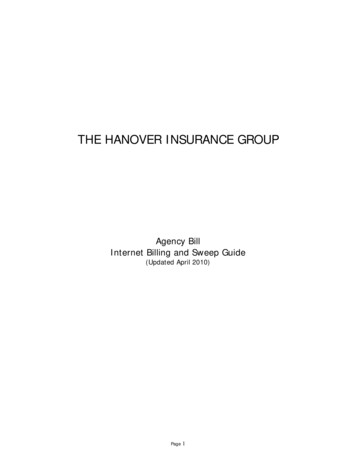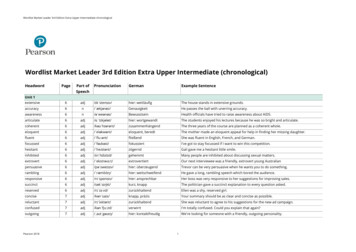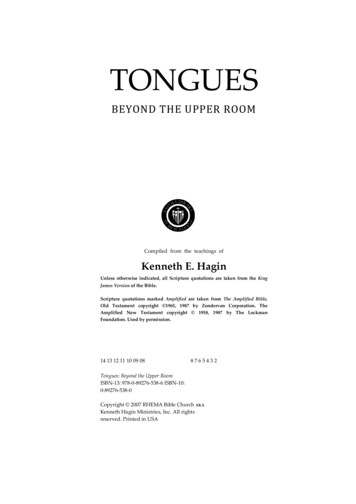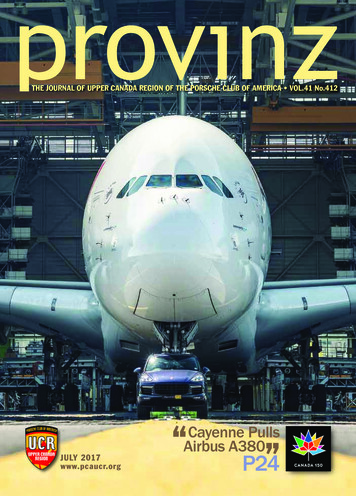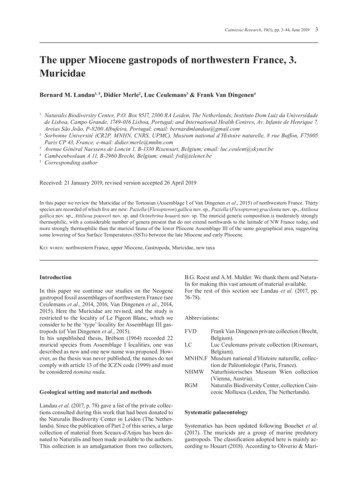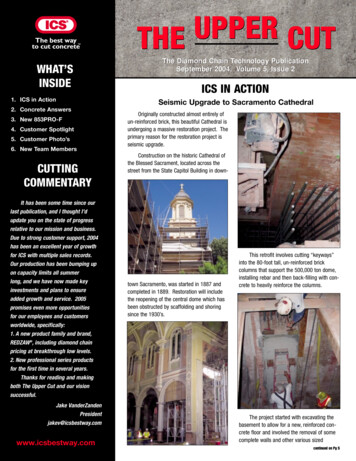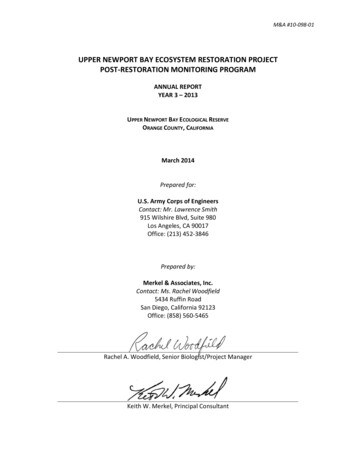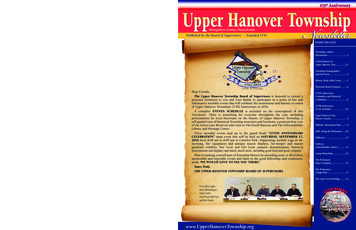
Transcription
Upper Hanover TownshipP.O. Box 27East Greenville, PA 18041PRESORTEDSTANDARDU.S. POSTAGEPAIDHarrisburg, PAPERMIT #609Montgomery County, PennsylvaniaPublished by the Board of Supervisors r Founded 1741NewsletterINSIDE THIS ISSUE:Township ContactInformation .2A Brief History ofUpper Hanover Twp .2-3Township Demographicsand Fun Facts.4This Community Newsletter is produced forUpper Hanover Township by Hometown Press215.257.1500 All rights reserved To Place An Ad Call Denise At Hometown Press 610-346-6126 DeniseOfHTP@yahoo.comPizza Y Pasta Y Steaks Y Hoagies Y Salads Y DessertsSTEPHEN REDDINGArboristBYOBPIZZERIA & RESTAURANTWi-Fi and PickUp Window atSellersville andGreen Laneat first BiteSellersvilleRt. 73 & 113218 S. Main St.337 Main St.610-584-4451215-257-5555215-679-6000Pennsburg Sun. - Thurs. 11am - 10pm Fri. & Sat. 11am - 11pm2995Large Plain Pizza & 40 WingsLimit 1. With this coupon only.Not valid with any other offer. Pleasepresent this coupon when ordering.Expires 6/30/16.215-257-7650Tree Service, Landscaping, Plant Health CareQuality work and integrity in our business dealingsare the hallmarks of Happy Tree.O Professional arborist services for all large trees including pruning,shaping, deadwood removal, cabling, bracing, cavity work, stormdamage repair, hazard evaluation, and tree removal.Pick Up Windowwww.ChiarosPizza.comFULLY INSURED REASONABLE RATES126 Reller Road Green Lane, PA 18054215-234-9222 Green Lane Rt. 29 Pick Up WindowSkippackwww.happytreeltd.com10% OFFAny Order Over 10.00Limit 1. With this coupon only.Not valid with any other offer. Pleasepresent this coupon when ordering.Expires 6/30/16.O Complete landscaping services from design through installation andmaintenance. Design services from our own in-house RegisteredLandscape Architect. We grow our own trees and shrubs to ensuretop quality, hardy installations.O Cutting-edge plant health care treatments, including nutritionalsupport, feeding, pest control, and treatment of disease.History Book Order Form .5Memorial Bench Program .6Dear Friends,The Upper Hanover Township Board of Supervisors is honored to extend apersonal invitation to you and your family to participate in a series of fun andinformative monthly events that will celebrate the momentous and historic occasionof Upper Hanover Township’s 275th Anniversary in 2016.A complete EVENTS SCHEDULE is included on the centerspread of thisNewsletter. There is something for everyone throughout the year, includingpresentations by local historians on the history of Upper Hanover Township, aself-guided tour of historical Township structures and locations, a pontoon boat tourof the Green Lane Reservoir and visits to The Knoll Museum and The SchwenkfelderLibrary and Heritage Center.These monthly events lead up to the grand finale “275TH ANNIVERSARYCELEBRATION” main event that will be held on SATURDAY, SEPTEMBER 17,2016 from 8:00 am to 6:00 pm at Camelot Park. Happenings include yoga in themorning, fire equipment and antique tractor displays, bee-keeper and mastergardener exhibits, Boy Scout and Girl Scout campsite demonstrations, historicalpresentations and displays and much, much more, including good food and good company.Plan on making yourself part of Township History by attending some or all of thesememorable and enjoyable events and share in the good fellowship and communitypride. WE WOULD LOVE TO SEE YOU THERE!Yours Truly,THE UPPER HANOVER TOWNSHIP BOARD OF SUPERVISORS275th AnniversaryEvent Schedule .7-8Upper Hanover TwpHistory Articles.9Millside Amusement Park .9Mills Along the Perkiomen.10Milltown.11Exibit atSchwenkfelder Library .11Camp Minnehaha.12The PerkiomenPaper Company.12The PerkiomenLehigh Path .13The Last Covered Bridge.13From left to right:Steve Rothenberger,Dottie Diehl,Gene Fried, Rich Fainand Ben Fiorito“SATISFACTION THAT GROWS!”www.UpperHanoverTownship.org275th AnniversaryCommittee and HistoricalCommittee.6www.UpperHanoverTownship.org
SERVICING BERKS, MONTGOMERY AND BUCKS COUNTIES Commercial Residential Construction & Demolition Recycling Landfills Roll-OffsGIVE US A CALL – LET’S TALK TRASH!(610) 440-37002955 Felton Road Norristown, PA 19401NorristownPA@AdvancedDisposal.com AdvancedDisposal.com The Only On-Site CrematoryCarl F. Slonaker, Jr., F.D., Supervisor222 Washington St.215-679-9589East Greenville, PA 18041Funeral & Cremation Serviceswww.mannslonakerfuneralhome.comPre-Need Payment PlansIn The Upper Perkiomen Valley
213The Perkiomen-Lehigh PathTownship Contact InformationOffice Hours are Monday through Friday, 8 a.m. to 4 p.m.1704 Pillsbury Road, PO Box 27, East Greenville, PA 18041Phone: 215-679-4401 r Fax: 215-679-3585 r www.upperhanovertownship.orgTownship Manager E-Mail: sseitzinger@comcast.netRoad Foreman E-Mail: tomluht@comcast.netFor Police, Fire and Medical Emergencies: Dial 911If you’ve lived in Upper Hanover Township for any period of time, you most likelyheard stories of farmers and others finding arrowheads or other Native American relicswhile plowing their fields or digging a new well.There are many fine Indian artifact collections in area museums, many of which werecollected near the Perkiomen Creek in Upper Hanover Township. But little is knownabout a major path used by Native Americans in another area of the township.In an article written in 1906, “well-known Allentown archeologist” D. N. Kern wasreported to have one of the most valuable collections of Indian relics in EasternPennsylvania. Among his collection was a 28-pound jasper sledgehammer from the VeraCruz mines.Kern also found “three medallion portraits made of brown jasper, two of themrepresenting the heads of men and the other that of a women.” These medallions werevery rare and the only other one known to exist was in Lebanon County.Native Americans worked the jasper pits and quarries at Vera Cruz, as well as others inLehigh and Bucks Counties back in the early 1700’s. As a matter of archeological record,they worked the quarries some 12,000 years before that!The quarries at Vera Cruz, in Lehigh County, were just a few hundred yards west ofthe town. It is one of many sites reported on the Pennsylvania Historical MuseumCommission’s National Register Listed Eligible Properties.The dark spots on the map mark the location ofAccording to the Commission, the earliest Native Americans quarried and shaped the the Perkiomen-Lehigh Path as it wound from thejasper “for tool making as early as ten thousand to twelve thousand years ago. Their banks of the Schuylkill River to the Jasper minesin Vera Cruz. Map is from Dr. Paul A. W.descendents continued to quarry and work this stone until the time of their first contact Wallace’s Indian Paths of Pennsylvania.with Europeans in the 17th century.”Researchers claim that the Jasper from Vera Cruz was traded into New Jersey, Delaware, and Western Pennsylvania. This sparkedsome interest in the various routes of travel used and Upper Hanover Township lies right in the middle of a major trail once usedby Native Americans on their travels on their way to the Jasper mines.According to Dr. Paul A. W. Wallace’s Indian Paths of Pennsylvania, “a path ran north from an Indian town on the Schuylkill atthe mouth of the Perkiomen Creek (about a mile south of Oaks) to the Vera Cruz jasper quarries.” The path was reported to haverun up the west side of the Perkiomen Creek, past modern day Schwenksville and Perkiomenville. It was reported to have crossedthe water where the Perkiomen and Macoby creeks meet in Green Lane. From there, the path crossed the hills between the twocreeks and continued north along the Macoby and Stony Run creeks, through Kleinville, in Upper Hanover Township, and on toGeryville, Hosensack, and the Jasper mines at Vera Cruz.The Last Covered BridgeMuch has been written about Markley’s Bridge over theyears. We know it today as the “Knight’s Road Bridge.”Built in 1835 at a cost of 2,500, it was an impressive coveredbridge that stretched for 301 feet to carry thePhiladelphia-Kutztown Road (known as Knight’s Road today)across the Perkiomen Creek in Upper Hanover Township. Thestructure sat upon four piers made out of red stone that wasquarried in the nearby hills. It served travelers at that locationfor 121 years.Among other names, the long, dimly lit passageway wasknown as the “kissing bridge.” It is remembered best asMarkley’s Bridge, the name affixed to it in 1874 when theMarkley family took ownership of the nearby mill.It was a sound structure that contained much of its originalwood when it was demolished. It seemed to be able to survivewhatever man and nature could throw at it.For instance, in 1920 a dump truck carrying 5 tons of logs tothe Boyertown Burial Casket Company crashed through thebridge as it attempted to cross and in 1925 when thePerkiomen Creek rose 16 feet above normal during one of theworst floods of our areas history.A dam in Hosensack and another in Palm broke under thetremendous pressure of the rising Hosensack and PerkiomenCreeks, sending a raging wall of water toward the Markley Bridge.Acting like a dam itself, the bridge stood strong against the flowand slowed the waterspreventing devastationdownstream.The coming of the Philadelphia Suburban Water Company’s(PSWC) reservoir eventually sounded the death knell for the oldbridge, but not until several efforts were made to save it.The reservoir would raise the level of the water under the bridgeby 20 feet. PSWC preferred not to have to raise the road above thelevel of the water, and petitioned to have Knights Road vacated.PSWC offered to disassemble the bridge piece-by-piece forreassembling in the Montgomery County Park near Green Lane.The Montgomery County Commissioners were in favor ofthat, but they also wanted the PSWC to raise Knight Road, keepit open, and help pay for a replacement bridge. Many localfolks favored keeping the bridge where it was, but raising it toa point safely above water level.Keeping the bridge and raising it 20 feet was not feasible andengineers advised against it. However, the courts ruled thatPSWC needed to keep Knight Right open, and raise it 20 feet.Montgomery County and PSWC officials were able to come toa compromise about sharing the cost of a new bridge, but nowfaced with a share of the cost of the building a new span bothsides faced shortfalls for preserving the old one and in 1956 thelongest covered bridge, and last remaining of its type inMontgomery County, was razed.Board of SupervisorsEugene F. Fried, ChairmanRichard K. Fain, Vice ChairmanDorothy J. Diehl, Assistant SecretaryBen R. Fiorito, Assistant TreasurerSteven R. RothenbergerStaffTownship Manager: Stanley W. Seitzinger, Jr.Road Foreman: Thomas LatshawMeeting ScheduleBoard of SupervisorsRegular Meeting: Second Tuesdayof each month at 7:00 p.m.Industrial Development AuthoritySecond Monday of the last monthof each quarter at 7:30 p.m.Workshop Meeting: Monday priorto each Regular Meeting at 7 p.m.Zoning Hearing BoardThird Wednesday of each month,as required, at 7 p.m.Planning CommissionRegular Meeting: First Wednesday ofeach month at 7:00 p.m.A Reminder.The Township Building will be closed onthe following holiday:May 3o – Memorial DayJuly 4 – Independence DaySeptember 5 – Labor DayParks and Recreation CommitteeFourth Monday of each month at 7 p.m.Historical CommitteeThird Tuesday of each month at 7 p.m.Upper Hanover AuthorityFirst Thursday of each month at 6:00 p.m.All meetings are open to the public and are held at: Upper Hanover Township MunicipalBuilding: 1704 Pillsbury Road, East Greenville, PAA Brief History of Upper Hanover TownshipNative American Peoples, probably “Lenape” of the Delaware tribe, made use of the abundant resources found in the UpperHanover Township area along with much of what we know of now as southeastern Pennsylvania. These Native Americanswere some of the first to make contact with European explorers and both benefited and sacrificed from these very early seventeenthcentury interactions.According to Dr. Paul A. W. Wallace’s Indian Paths of Pennsylvania, “a path ran north from an Indian town on the Schuylkill atthe mouth of the Perkiomen Creek (about a mile south of Oaks, Pa.) to the Vera Cruz jasper quarries” in Lehigh County.The path was reported to have run up the west side of the Perkiomen Creek, past modern day Schwenksville and Perkiomenville.It was reported to have crossed the water where the Perkiomen and Macoby creeks meet in Green Lane. From there, the pathcrossed the hills between the two creeks and continued north along the Macoby and Stony Run creeks, through Kleinville, inUpper Hanover Township, and on to Geryville, Hosensack, and the Jasper mines at Vera Cruz.Ultimately, the land became under control of the William Penn family who, through an aggressive settlement campaign,eventually moved the Native populations further westward.Meanwhile religious, social and economic tensions in the Germanic city-states of Europe, particularly religious intolerance andthe unrest resulting from the Thirty Years War (1618-1648), drove many German speaking peoples away from their homes. Largenumbers fled to Philadelphia, induced by the promise of religious tolerance and a vision of economic opportunity. From there,some made their way to what is now Upper Hanover Township. Among the many German language religious groups settling thistownship were Lutherans, Reformed, Catholic, Mennonites and Schwenkfelders.Before 1741, Upper Hanover was part of Hanover Township along with Douglass, Pottsgrove, and New Hanover Townships andthe Borough of Pottstown. Upper Hanover became a separate township from Hanover Township in 1741 and, at that time, itscontinued on page 3.The Loft at Sweet Water CountryClub is the area’s premier weddingand banquet facility. We offer brandnew indoor and outdoor settingswith spectacular views situatedon a magnificent golf course.2554 GERYVILLE PIKEPENNSBURG PA 18073PH: 215.679.8111 FX: 215.541.1893INFO@GOLFSWEETWATER.COMWedding specialists will workwith you to make sure yourdesires are met with old fashionhospitality, elegant cuisine andoutstanding service.THELOFTATSWEETWATERCOUNTRYCLUB.COM
123A Brief History of Upper Hanover Township .continued from page 2boundaries also included the three villages of Palm, Kleinville, and Hillegassville, in addition to the settlements which nowconstitute the Boroughs of Pennsburg, Red Hill and East Greenville.The township’s rich soil attracted excellent German farmers who settled in the area. Industrial activity was second only toagriculture in importance during this early period. Theprimary industry was building construction. Utilizing graniteboulders, provided from the Hosensack Hills, facilitated this.Waterpower was also available from the Perkiomen Creek andpropelled water wheels for five gristmills and four sawmills.In 1851, the Goshenhoppen and Green Lane Turnpike (todayknown as Route 29 or Gravel Pike) was completed. TheGeryville and Sumneytown Turnpike, finished in 1865, alsocrossed the eastern portion of the township.The Perkiomen Railroad, aided by the Reading Railroad,constructed and opened a rail line from Collegeville to UpperHanover Township in 1873. The line was extended to Emmausin 1874. By 1878 mail service, via the railroad, reached thetrain stations in Upper Hanover Township.Livestock arrived on the rail cars for the large, public auctions in the Township. Lumber, coal, and raw materials to supply thelocal factories arrived by train. Finished goods, milk, and vegetables were shipped to the city in the same way.With the railroad, travelers were able to enjoy a much easier commute to the popular township recreation destinations.The railroad also brought the ice industry to the township. The close proximity to the exceptional waters of the PerkiomenCreek and access to the railroad made ice making a major industry between 1890 and the early 1920’s.The largest icehouse built in Upper Hanover Township was the structure erected in Palm by the Hancock Ice Company. Builtin 1897, it was 311 feet long, 90 feet wide and 42 feet high! The coming of electric freezers made the ice industry obsolete andthe flood of 1935 wiped out almost all of the ice dams on the Perkiomen Creek that had once supported the ice industry.During World War II many of the valley’s workers traveled to industrial centers (i.e. Pottstown, Allentown, Lansdale, etc.)outside the valley to find employment in the war effort.In 1950 a fierce controversy gripped the valley. The Philadelphia Suburban Water Company wanted to impound three billiongallons of the Perkiomen Creek’s water to supply municipalities at the eastern end of Montgomery County. Valley residents felt theirwater rights were being confiscated. The citizens of the valley organized, took the issue to court, and lost. Construction on the damstarted in 1954. The reservoir and its surrounding parklands are now an important landmark and recreation area for the valley.In 1948, Upper Hanover Township had a total of nine schoolhouses. Though it had been discussed on numerous occasions, theformation of the Upper Perkiomen School District was still several years away. Schools in East Greenville and Pennsburg weregrowing, but student enrollment in Upper Hanover was waning. Five of the schoolhouses, one dating back to 1855, were sold in 1948.The Upper Perkiomen Valley School District was formed in 1954. Red Hill, Pennsburg, East Greenville, Green Lane,Marlborough, Upper Hanover, and Hereford Township in Berks County merged to better serve school needs in the valley. Amultimillion-dollar high school was constructed, spanning part of Red Hill and Upper Hanover Township.Over the next few decades major growth and changes occurred in Upper Hanover Township. Industries such as Knoll, Inc.,Brown Printing and Blommer Chocolates located their business in the Township. Housing development flourished in the earlyyears of the 21st century and boosted the population to 7,124 residents by 2016. A major shopping center, The Shoppes at UpperHanover, opened for business in 2006. Despite the recent growth, Upper Hanover Township has maintained its rural characterthrough active coordination with the Montgomery County Open Space Program and the Farmland Preservation Program.Local Delivery10.00 MinimumCOLDBEER TOGO642 Gravel Pike (Rt. 29)East Greenville, PA 18041Spotlight on History: Camp MinnehahaThe banks of the Perkiomen Creek were quite a vacationattraction in the late 1800’s and early 1900’s. Vacationresorts and summer camps dotted the water’s edge from Palmto Collegeville. Most of the nearby camps were started to giveyoung people an outdoor education and a chance to experiencethe camaraderie and fun that camping brings.One such camp was known as Camp Minnehaha. The nameis said to be Native American for Laughing Waters.Kehl Markley, Jr. first opened the camp in June 1922. It waslocated directly north of the longest covered bridge inMontgomery County, and across the creekfrom one of the earliest mills in our region.The land was known as the Markleyproperty and there where two houseslocated on the site back then. It includeda 14-room stone house where Kehl lived,and another house where Asa P. Markleyresided. Asa operated the MinnehahaChopping Mill at the time the camp wasstarted. But the mill business at thatlocation dates back to 1727 when German immigrants Georgeand Margaret Welker built the first one there!In the early years, many of the campers were boys from thePerkiomen School. Most of them were from other states. Somewere from other countries! Usually 30 or so youngsters, age 8to 16, would spend time together at the camp and enjoy tennis,baseball, basketb
support, feeding, pest control, and treatment of disease. STEPHEN REDDING Arborist . Markley’s Bridge, the name affixed to it in 1874 when the Markley family took ownership of the nearby mill. It
